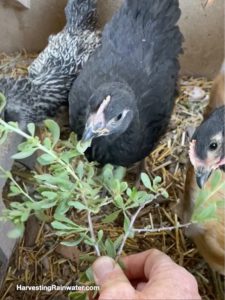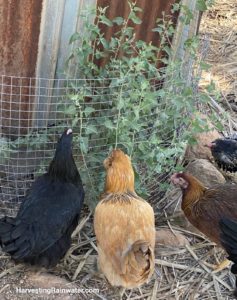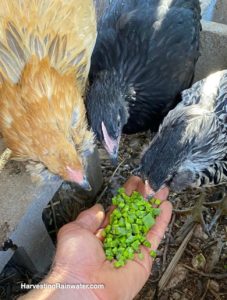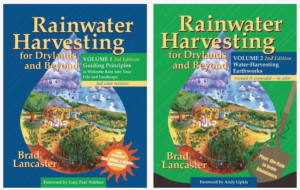Revised and Expanded List of Plants for Chickens in the Sonoran Desert
by Brad Lancaster
www.HarvestingRainwater.com
Why buy all food or materials for shade structures for your chickens when you can grow many of these resources and more?
Plants native to your area and your site’s microclimates are the best since they are best adapted to your local conditions, and won’t need supplemental irrigation once established. Passively harvest rainwater and/or greywater for them and the won’t just survive – they will thrive!
The chickens will let you know what they like and don’t like. I bring them cuttings of a plant to taste (figure 1). If they like it, I’ll plant one or two for them in their chicken yard (figure 2). But I also fence the plant so the chickens won’t eat it to the ground and kill it. Instead, the chickens just eat what grows through the fencing. As the plants grow they eventually develop a shading/sheltering canopy as well. And the chickens nibble on and prune the growth that droops down to their height.


Some plants such as the mostly thornless nopal cactus pads will be chewed on by the chickens, but when young the chickens like it better if I cut up the pads into bite-sized cubes (figure 3). Now that the chickens are full-grown and they’ve regularly feasted on the nopal cactus, I can give them a full pad (not cut up at all) and the chickens will devour it. This is a great food in our hot summers as it helps cool the birds and hydrate them.

You can also consult books on the ethnobotanical (human) uses of your region’s native plants or your local Game and Fish department or books that list what plants local chicken-like birds—such as quail and wild turkeys—like to eat. Most likely, chickens will like to eat those plants too. An example of one such book I’ve used is American Wildlife and Plants: A Guide to Wildlife Food Habits by Martin, Alexander C., Herbert S. Herbert, and Arnold L. Nelson New York: Dover Publications, 1951.
Chickens also like to eat most of the plant foods we eat.
Click here for the revised and expanded list of plants for chickens in the Sonoran Desert
Click here for a list of good and bad plants for goats in the Sonoran and Chihuahuan Deserts
And for more info on how to freely irrigate your chicken plants with the rain and other free on-site waters such as greywater and air-conditioning condensate check out the revised, full-color editions of my books…

